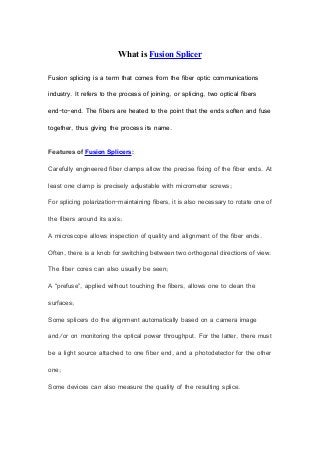
What is fusion splicer
- 1. What is Fusion Splicer Fusion splicing is a term that comes from the fiber optic communications industry. It refers to the process of joining, or splicing, two optical fibers end-to-end. The fibers are heated to the point that the ends soften and fuse together, thus giving the process its name. Features of Fusion Splicers: Carefully engineered fiber clamps allow the precise fixing of the fiber ends. At least one clamp is precisely adjustable with micrometer screws; For splicing polarization-maintaining fibers, it is also necessary to rotate one of the fibers around its axis; A microscope allows inspection of quality and alignment of the fiber ends. Often, there is a knob for switching between two orthogonal directions of view. The fiber cores can also usually be seen; A “prefuse”, applied without touching the fibers, allows one to clean the surfaces; Some splicers do the alignment automatically based on a camera image and/or on monitoring the optical power throughput. For the latter, there must be a light source attached to one fiber end, and a photodetector for the other one; Some devices can also measure the quality of the resulting splice.
- 2. The process of Fusion Splicing involves using localized heat to melt or fuse the ends of two optical fibers together. The Splicing process begins by preparing each Fiber end for fusion. Fusion splicing requires that all protective coatings be removed from the ends of each fiber. The fiber is then cleaved using the score-and-break method. The quality of each fiber end is inspected using a microscope. In fusion splicing, Splice Loss is a direct function of the angles and quality of the two fiber-end faces. Before optical fibers can be successfully fusion-spliced, they need to be carefully stripped of their outer jackets and polymer coating, thoroughly cleaned, and then precisely cleaved to form smooth, perpendicular end faces. Once all of this has been completed, each fiber is placed into a holder in the splicer’s enclosure. Cleaning the splicing device and the fiber Since the slightest trace of dust or other impurities can wreak havoc on a splice’s ability to transmit optical signals, you can never be too clean when it comes to fusion splicing. Even though fibers are hand-cleaned before being inserted into the splicing device, many fusion splicers incorporate an extra precautionary cleaning step into the process: prior to fusing, they generate a small spark between the fiber ends to burn off any remaining dust or moisture.
- 3. The fiber is then cleaved using the score-and-break method so that its endface is perfectly flat and perpendicular to the axis of the fiber. The quality of each fiber end is inspected using a microscope. In fusion splicing, splice loss is a direct function of the angles and quality of the two fiber-end faces. The closer to 90 degrees the cleave angle is the lower optical loss the splice will yield. Splicing Optic Fiber The splicer emits a second, larger spark that melts the optical fiber end faces without causing the fibers’ cladding and molten glass core to run together. The melted fiber tips are then joined together, forming the final fusion splice. Estimated splice-loss tests are then performed, with most fiber fusion splices showing a typical optical loss of 0.1 dB or less. Fibercasa is the recognized leader in the development of the highest quality fusion splicing equipment and accessories that have and continue to advance fusion splicing technology. You have a wide selection of fiber optic splicing relevant equipments, like fusion splicer, fiber optic cleaver, fiber cleaver blades, fusion splicer assemblies, etc. View:www.fibercasa.com for more information
